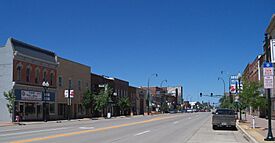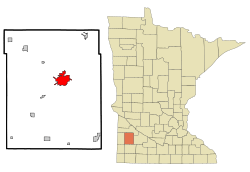Marshall, Minnesota facts for kids
Quick facts for kids
Marshall
|
|
|---|---|

Main Street in downtown Marshall
|
|
| Motto(s):
"Cultivating the Best in Us"
|
|

|
|
| Country | United States |
| State | Minnesota |
| County | Lyon |
| Platted | 1872 |
| Incorporated (village) | 1876 |
| Incorporated (city) | February 20, 1901 |
| Government | |
| • Type | Mayor – Council |
| Area | |
| • Total | 10.22 sq mi (26.48 km2) |
| • Land | 10.22 sq mi (26.46 km2) |
| • Water | 0.01 sq mi (0.02 km2) |
| Elevation | 1,161 ft (354 m) |
| Population
(2020)
|
|
| • Total | 13,628 |
| • Estimate
(2023)
|
13,906 |
| • Density | 1,333.86/sq mi (515.02/km2) |
| Time zone | UTC−6 (Central (CST)) |
| • Summer (DST) | UTC−5 (CDT) |
| ZIP Code |
56258
|
| Area code(s) | 507 |
| FIPS code | 27-40688 |
| GNIS feature ID | 2395022 |
| Sales tax | 7.375% |
Marshall is a city in Lyon County, Minnesota, United States. It's a busy place in southwest Minnesota and is the main city for Lyon County. In 2020, about 13,628 people lived here. Marshall is also home to the main office of the Schwan Food Company and Southwest Minnesota State University.
Contents
History of Marshall
Marshall was first planned out in 1872. This happened when the railroad lines were built to reach this spot. Before the city was officially created, the area was called Lake Marshall Township. It already had a post office and some farms. Sometimes, groups of Dakota people used the site as a camping ground. They hunted and traveled all over this region.
After a lot of discussion, the town was named Marshall. It was named after Governor William R. Marshall. The town grew very quickly. In 1873, the first newspaper, the Prairie Schooner, was started. Its first issue said that only nine months earlier, the first house was built. But by then, there were already 79 buildings, with more being planned!
Marshall became an official village in 1876. Then, on February 20, 1901, it became a city. In 1874, about 300 people lived in Marshall. By 1900, the population had grown to 2,088. Important buildings like Holy Redeemer Catholic Church (1884) and Weiner Memorial Hospital (1950) were built. Also in the 1950s, Marvin Schwan started his ice cream delivery service. This small business grew into the huge Schwan Food Company.
The Redwood River flows through Marshall. In the past, the river often flooded the city. This was a big problem in the 1940s and 1950s. To help, special channels were built between 1961 and 1963. Even with these, some flooding still happened, like in 1993. More work was done in 1997 and 2000 to improve the river channels. This has helped control the water better.
Southwest Minnesota State University was started in 1963. Its campus was mostly built between 1967 and 1973.
Where is Marshall?
Marshall is located in a mostly rural area. This area used to be covered by tall tallgrass prairie. The city is about 150 km (93 mi) northeast of Sioux Falls, South Dakota. It's also about 238 km (148 mi) southwest of Minneapolis. The city sits about 354 meters (1,161 feet) above sea level.
Several main roads pass through Marshall. These include U.S. Highway 59 and Minnesota State Highways 19, 23, and 68. You can also travel to and from Marshall by bus using Greyhound Bus Lines.
The Southwest Minnesota Regional Airport-Marshall/Ryan Field is a local airport. It has a long runway that can handle large airplanes. While there are no regular passenger flights, you can arrange special charter flights.
Marshall's Climate
Marshall has a climate with warm summers and cold, snowy winters. Here's a look at the average temperatures and rainfall:
| Climate data for Marshall, Minnesota (1991−2020 normals, extremes 1935−present) | |||||||||||||
|---|---|---|---|---|---|---|---|---|---|---|---|---|---|
| Month | Jan | Feb | Mar | Apr | May | Jun | Jul | Aug | Sep | Oct | Nov | Dec | Year |
| Record high °F (°C) | 67 (19) |
65 (18) |
83 (28) |
94 (34) |
101 (38) |
106 (41) |
109 (43) |
106 (41) |
102 (39) |
94 (34) |
80 (27) |
73 (23) |
109 (43) |
| Mean maximum °F (°C) | 45.5 (7.5) |
50.6 (10.3) |
66.6 (19.2) |
80.8 (27.1) |
90.1 (32.3) |
94.6 (34.8) |
95.4 (35.2) |
93.1 (33.9) |
90.3 (32.4) |
83.4 (28.6) |
65.5 (18.6) |
49.0 (9.4) |
97.6 (36.4) |
| Mean daily maximum °F (°C) | 24.5 (−4.2) |
29.0 (−1.7) |
41.2 (5.1) |
56.8 (13.8) |
70.1 (21.2) |
80.6 (27.0) |
84.7 (29.3) |
82.2 (27.9) |
75.3 (24.1) |
60.2 (15.7) |
43.3 (6.3) |
29.6 (−1.3) |
56.5 (13.6) |
| Daily mean °F (°C) | 14.0 (−10.0) |
18.3 (−7.6) |
30.3 (−0.9) |
44.5 (6.9) |
58.1 (14.5) |
68.9 (20.5) |
72.9 (22.7) |
70.4 (21.3) |
62.4 (16.9) |
48.1 (8.9) |
32.9 (0.5) |
19.9 (−6.7) |
45.1 (7.3) |
| Mean daily minimum °F (°C) | 3.6 (−15.8) |
7.5 (−13.6) |
19.5 (−6.9) |
32.2 (0.1) |
46.1 (7.8) |
57.2 (14.0) |
61.0 (16.1) |
58.6 (14.8) |
49.5 (9.7) |
36.0 (2.2) |
22.5 (−5.3) |
10.1 (−12.2) |
33.7 (0.9) |
| Mean minimum °F (°C) | −16.4 (−26.9) |
−12.6 (−24.8) |
−1.9 (−18.8) |
19.1 (−7.2) |
32.6 (0.3) |
46.6 (8.1) |
50.9 (10.5) |
48.5 (9.2) |
35.5 (1.9) |
20.8 (−6.2) |
4.7 (−15.2) |
−10.4 (−23.6) |
−19.8 (−28.8) |
| Record low °F (°C) | −32 (−36) |
−36 (−38) |
−24 (−31) |
2 (−17) |
21 (−6) |
32 (0) |
42 (6) |
38 (3) |
22 (−6) |
5 (−15) |
−15 (−26) |
−34 (−37) |
−36 (−38) |
| Average precipitation inches (mm) | 0.86 (22) |
0.87 (22) |
1.60 (41) |
2.79 (71) |
3.66 (93) |
4.10 (104) |
3.78 (96) |
3.61 (92) |
3.06 (78) |
2.29 (58) |
1.26 (32) |
1.02 (26) |
28.90 (734) |
| Average snowfall inches (cm) | 6.6 (17) |
8.1 (21) |
7.6 (19) |
4.9 (12) |
0.1 (0.25) |
0.0 (0.0) |
0.0 (0.0) |
0.0 (0.0) |
0.0 (0.0) |
0.8 (2.0) |
5.3 (13) |
10.1 (26) |
43.5 (110) |
| Average precipitation days (≥ 0.01 in) | 5.3 | 5.3 | 6.0 | 8.5 | 11.3 | 11.0 | 8.4 | 8.3 | 7.3 | 7.6 | 5.0 | 5.4 | 89.4 |
| Average snowy days (≥ 0.1 in) | 4.8 | 4.8 | 3.3 | 1.5 | 0.1 | 0.0 | 0.0 | 0.0 | 0.0 | 0.5 | 2.5 | 5.1 | 22.6 |
| Source: NOAA | |||||||||||||
People of Marshall
| Historical population | |||
|---|---|---|---|
| Census | Pop. | %± | |
| 1880 | 961 | — | |
| 1890 | 1,203 | 25.2% | |
| 1900 | 2,088 | 73.6% | |
| 1910 | 2,152 | 3.1% | |
| 1920 | 3,092 | 43.7% | |
| 1930 | 3,250 | 5.1% | |
| 1940 | 4,590 | 41.2% | |
| 1950 | 5,923 | 29.0% | |
| 1960 | 6,681 | 12.8% | |
| 1970 | 9,886 | 48.0% | |
| 1980 | 11,161 | 12.9% | |
| 1990 | 12,023 | 7.7% | |
| 2000 | 12,735 | 5.9% | |
| 2010 | 13,680 | 7.4% | |
| 2020 | 13,628 | −0.4% | |
| 2023 (est.) | 13,906 | 1.7% | |
| U.S. Decennial Census 2020 Census |
|||
In 2010, there were 13,680 people living in Marshall. About 22.6% of the people were under 18 years old. The average age in the city was 29.7 years.
Most people in Marshall identify with a religion. About 34.5% are Catholic and 31.4% are Protestant. A small number, 2.9%, follow other Christian faiths.
Marshall's Economy
Marshall is home to some big companies that provide many jobs.
- Schwan's Company: This company started in Marshall and is one of the largest frozen food companies in the country. They make a lot of frozen pizzas and egg rolls. They are also famous for their frozen desserts and ice cream. About 1,500 people work for Schwan's in Marshall. One of the streets downtown is even named Marvin Schwan Memorial Drive, after the company's founder.
- Archer Daniels Midland Company (ADM): This company has a large facility in Marshall that processes corn. It used to be run by a group of farmers. Now, it's part of ADM and employs 250 people.
- Runnings: This is a regional store chain that sells many different products. Its main office is located in Marshall.
Other important employers in the city include:
- US Bancorp (a bank)
- Affiliated Community Medical Centers (ACMC)
- Avera Marshall Regional Medical Center (a hospital)
- Hy-Vee (a grocery store)
- Walmart (a large retail store)
- Menards (a home improvement store)
- Southwest Minnesota State University
- Turkey Valley Farms
- Marshall Public Schools
Education in Marshall
Marshall has several schools for students of all ages.
Public Schools
The public schools in Marshall are part of District 413. They include:
- Marshall High School
- Marshall Middle School
- Parkside Elementary
- West Side Elementary
There's also Marshall East Campus Learning Alternatives for grades 7–12. The sports teams for Marshall schools are called the Tigers.
Private Schools
Marshall also has private schools:
- Holy Redeemer
- True Light Christian
- Samuel Lutheran School
Libraries and Universities
The Marshall-Lyon County Library is a great place to find books and other materials. It has over 75,000 books, plus audio and video materials. It's part of the Plum Creek Library System.
Southwest Minnesota State University is a public university in Marshall. It offers four-year degrees in many subjects. About 3,500 students attend the university.
Famous People from Marshall
Many interesting people have connections to Marshall:
- Ruth Anderson (b. 1899), was the oldest living person in Minnesota before she passed away in 2011.
- Blaise Andries (b. 1998), a football player.
- John Ely Burchard (1898–1975), a professor and dean at the Massachusetts Institute of Technology.
- Bill Gullickson (b. 1959), a former Major League Baseball pitcher.
- Carly Gullickson, a professional tennis player and Bill Gullickson's daughter.
- Trey Lance, an American football quarterback.
- Marvin Schwan, who founded the Schwan Food Company.
- Sean Tillmann (b. 1978), also known as Har Mar Superstar, a singer-songwriter and actor.
- Isiah Whitlock Jr., an actor known for The Wire, who studied theater at Southwest Minnesota State University.
- Steve Zahn (b. 1967), a well-known film and stage actor.
See also
 In Spanish: Marshall (Minnesota) para niños
In Spanish: Marshall (Minnesota) para niños

